Research on Flood Storage and Disaster Mitigation Countermeasures for Floods in China’s Dongting Lake Area Based on Hydrological Model of Jingjiang–Dongting Lake
Abstract
1. Introduction
2. Study Area and Data
2.1. Study Area
2.2. Data Sources
3. Methods
3.1. Jingjiang–Dongting Lake Hydrological Model
3.1.1. Flood Routing Model
3.1.2. Interval Runoff Generation and Concentration Model
3.1.3. Parameter Processing
- (1)
- The stage–discharge relationship at Luoshan
- (2)
- Diversion of water flow through three outlets during high water levels
- (3)
- Calculation of excess flood volume
3.1.4. Parameter Optimization
3.2. Evaluation Indices for Model Effects
3.3. Scenario Design
4. Results
4.1. Training and Verification of Jingjiang–Dongting Lake Hydrological Model
4.2. Impact on Flood Control Situations in Dongting Lake Under Different Flood Scenarios
4.2.1. Scenario of Elevated Flood Control Water Level
4.2.2. Scenario of Using Flood Storage and Detention Areas
5. Discussion
5.1. Analysis of the Impact of River–Lake Conditions on the Flood Control Situation near Chenglingji
5.2. The Limitation of the Study
6. Conclusions
Author Contributions
Funding
Data Availability Statement
Acknowledgments
Conflicts of Interest
References
- Masson-Delmotte, V.; Zhai, P.; Pirani, S.; Connors, C.; Péan, S.; Berger, N.; Caud, Y.; Chen, L.; Goldfarb, M.; Scheel Monteiro, P.M. Ipcc, 2021: Summary for policymakers. In Proceedings of the Climate Change 2021: The Physical Science Basis. Contribution of Working Group I to the Sixth Assessment Report of the Intergovernmental Panel on Climate Change; Cambridge University Press: Cambridge, UK; New York, NY, USA, 2021. [Google Scholar]
- Mirza, M.M.Q. Global warming and changes in the probability of occurrence of floods in Bangladesh and implications. Glob. Environ. Chang. 2002, 12, 127–138. [Google Scholar] [CrossRef]
- Bates, P.D. Flood Inundation Prediction. Annu. Rev. Fluid Mech. 2022, 54, 287–315. [Google Scholar] [CrossRef]
- Brunner, M.I.; Slater, L.; Tallaksen, L.M.; Clark, M. Challenges in modeling and predicting floods and droughts: A review. WIREs Water 2021, 8, e1520. [Google Scholar] [CrossRef]
- Patel, D.P.; Ramirez, J.A.; Srivastava, P.K.; Bray, M.; Han, D. Assessment of flood inundation mapping of Surat city by coupled 1D/2D hydrodynamic modeling: A case application of the new HEC-RAS 5. Nat. Hazards 2017, 89, 93–130. [Google Scholar] [CrossRef]
- Yang, T.-H.; Liu, W.-C. A General Overview of the Risk-Reduction Strategies for Floods and Droughts. Sustainability 2020, 12, 2687. [Google Scholar] [CrossRef]
- Fekete, B.M.; Bogárdi, J.J. Role of engineering in sustainable water management. Earth Perspect. 2015, 2, 2. [Google Scholar] [CrossRef]
- Lebu, S.; Lee, A.; Salzberg, A.; Bauza, V. Adaptive strategies to enhance water security and resilience in low-and middle-income countries: A critical review. Sci. Total Environ. 2024, 925, 171520. [Google Scholar] [CrossRef]
- Teraguchi, H.; Nakagawa, H.; Kawaike, K.; Yasuyuki, B.; Zhang, H. Effects of hydraulic structures on river morphological processes. Int. J. Sediment Res. 2011, 26, 283–303. [Google Scholar] [CrossRef]
- Vionnet, V.; Fortin, V.; Gaborit, E.; Roy, G.; Abrahamowicz, M.; Gasset, N.; Pomeroy, J.W. Assessing the factors governing the ability to predict late-spring flooding in cold-region mountain basins. Hydrol. Earth Syst. Sci. 2020, 24, 2141–2165. [Google Scholar] [CrossRef]
- Contreras, M.T.; Gironás, J.; Escauriaza, C. Forecasting flood hazards in real-time: A surrogate model for hydrometeorological events in an Andean watershed. Nat. Hazards Earth Syst. Sci. Discuss. 2020, 20, 3261–3277. [Google Scholar] [CrossRef]
- Kumar, V.; Sharma, K.; Caloiero, T.; Mehta, D.; Singh, K. Comprehensive Overview of Flood Modeling Approaches: A Review of Recent Advances. Hydrology 2023, 10, 141. [Google Scholar] [CrossRef]
- Zou, J.; Huang, F.; Yu, F.; Shen, X.; Han, S.; Qian, Z.; Jiang, H. Differentiating the Effects of Streamflow and Topographic Changes on the Water Level of Dongting Lake, China, Using the LSTM Network and Scenario Analysis. Water 2023, 15, 3742. [Google Scholar] [CrossRef]
- Ansarifard, S.; Eyvazi, M.; Kalantari, M.; Mohseni, B.; Ghorbanifard, M.; Moghaddam, H.J.; Nouri, M. Simulation of floods under the influence of effective factors in hydraulic and hydrological models using HEC-RAS and MIKE 21. Discov. Water 2024, 4, 92. [Google Scholar] [CrossRef]
- Long, Y.; Chen, W.; Jiang, C.; Huang, Z.; Yan, S.; Wen, X. Improving streamflow simulation in Dongting Lake Basin by coupling hydrological and hydrodynamic models and considering water yields in data-scarce areas. J. Hydrol. Reg. Stud. 2023, 47, 101420. [Google Scholar] [CrossRef]
- Chen, Y.; Wang, Y.; Zhang, Y.; Luan, Q.; Chen, X. Flash floods, land-use change, and risk dynamics in mountainous tourist areas: A case study of the Yesanpo Scenic Area, Beijing, China. Int. J. Disaster Risk Reduct. 2020, 50, 101873. [Google Scholar] [CrossRef]
- Suwannachai, L.; Sriworamas, K.; Sivanpheng, O.; Kangrang, A. Application of SWAT Model for Assessment of Surface Runoff in Flash Flood Areas. Water 2024, 16, 495. [Google Scholar] [CrossRef]
- Salvati, A.; Moghaddam Nia, A.; Salajegheh, A.; Shirzadi, A.; Shahabi, H.; Ahmadisharaf, E.; Han, D.; Clague, J.J. A systematic review of Muskingum flood routing techniques. Hydrol. Sci. J. 2024, 69, 810–831. [Google Scholar] [CrossRef]
- Zhou, Q.; Teng, S.; Situ, Z.; Liao, X.; Feng, J.; Chen, G.; Zhang, J.; Lu, Z. A deep-learning-technique-based data-driven model for accurate and rapid flood predictions in temporal and spatial dimensions. Hydrol. Earth Syst. Sci. 2023, 27, 1791–1808. [Google Scholar] [CrossRef]
- Chafjiri, A.S.; Gheibi, M.; Chahkandi, B.; Eghbalian, H.; Waclawek, S.; Fathollahi-Fard, A.M.; Behzadian, K. Enhancing flood risk mitigation by advanced data-driven approach. Heliyon 2024, 10, e37758. [Google Scholar] [CrossRef]
- Zhang, K.; Ji, Z.; Luo, X.; Liu, Z.; Zhong, H. Flood Simulation in the Complex River Basin Affected by Hydraulic Structures Using a Coupled Hydrological and Hydrodynamic Model. Water 2024, 16, 2383. [Google Scholar] [CrossRef]
- Huang, H.; Lei, X.; Liao, W.; Liu, D.; Wang, H. A hydrodynamic-machine learning coupled (HMC) model of real-time urban flood in a seasonal river basin using mechanism-assisted temporal cross-correlation (MTC) for space decoupling. J. Hydrol. 2023, 624, 129826. [Google Scholar] [CrossRef]
- Pang, C.; Zhou, Z.; Liu, J.; Tianyu, S.; Du, C.; Wang, K.; Yu, X. Parallel computing performance of distributed hydrological model accelerated by GPU. South-North Water Transf. Water Sci. Technol. 2024, 22, 33–38. [Google Scholar]
- Zhang, D.; Shi, X.; Xu, H.; Jing, Q.; Pan, X.; Liu, T.; Wang, H.; Hou, H. A GIS-based spatial multi-index model for flood risk assessment in the Yangtze River Basin, China. Environ. Impact Assess. Rev. 2020, 83, 106397. [Google Scholar] [CrossRef]
- Zhang, C.; Sun, F.; Sharma, S.; Zeng, P.; Mejia, A.; Lyu, Y.; Gao, J.; Zhou, R.; Che, Y. Projecting multi-attribute flood regime changes for the Yangtze River basin. J. Hydrol. 2023, 617, 128846. [Google Scholar] [CrossRef]
- Duan, G.-L.; Long, H.; Guo, M.-J. Evolvement of Riverbed Near Bank of Dangerous Reach along Jingjiang River Levee after the Impoundment of Three Gorges Reservoir. J. Yangtze River Sci. Res. Inst. 2014, 31, 117. [Google Scholar]
- Jiang, Y.-H.; Cheng, H.-Q.; Zhou, Q.-P.; Li, Y.; Yang, G.-Q.; Jin, Y.; Mei, S.-J.; Gu, X.; Zhang, H. Influence of major water conservation projects on river channels and shorelines in the middle and lower reaches of the Yangtze River. Arab. J. Geosci. 2021, 14, 884. [Google Scholar] [CrossRef]
- Li, S.; Li, Y.; Yuan, J.; Zhang, W.; Chai, Y.; Ren, J. The impacts of the Three Gorges Dam upon dynamic adjustment mode alterations in the Jingjiang reach of the Yangtze River, China. Geomorphology 2018, 318, 230–239. [Google Scholar] [CrossRef]
- Chang, J.; Li, J.; Lu, D.; Zhu, X.; Lu, C.; Zhou, Y.; Deng, C. The hydrological effect between Jingjiang River and Dongting Lake during the initial period of Three Gorges Project operation. J. Geogr. Sci. 2010, 20, 771–786. [Google Scholar] [CrossRef]
- Liao, S.; Wang, C.; Ji, R.; Zhang, X.; Wang, Z.; Wang, W.; Chen, N. Balancing Flood Control and Economic Development in Flood Detention Areas of the Yangtze River Basin. ISPRS Int. J. Geo-Inf. 2024, 13, 122. [Google Scholar] [CrossRef]
- Xia, J.; Chen, J. A new era of flood control strategies from the perspective of managing the 2020 Yangtze River flood. Sci. China Earth Sci. 2021, 64, 1–9. [Google Scholar] [CrossRef]
- Xing, L.; Zhang, D.-D.; Shuai, L. Influence of Three Gorges Reservoir on Flood Regime of Mid-lower Reaches of Yangtze River. Water Resour. Power 2019, 37, 44–46. [Google Scholar]
- Hu, C.; Zhang, S. Discussion on development and protection strategy of Yangtze River. Yangtze River 2020, 51, 1–5. [Google Scholar]
- Shen, X.; Liu, X.; Zhao, W. Reflections on Flood Control in the Middle Reaches of Yangtze River. Technol. Econ. Change 2023, 7, 43–48. [Google Scholar]
- Lai, X.; Jiang, J.; Yang, G.; Lu, X.X. Should the Three Gorges Dam be blamed for the extremely low water levels in the middle–lower Yangtze River? Hydrol. Process. 2013, 28, 150–160. [Google Scholar] [CrossRef]
- Wang, H.; Sun, F.; Liu, W. Characteristics of streamflow in the main stream of Changjiang River and the impact of the Three Gorges Dam. Catena 2020, 189, 104498. [Google Scholar] [CrossRef]
- Bureau of Hydrology, Changjiang Water Resources Commission. The 1954 Flood of the Yangtze River; Changjiang Publishing House: Wuhan, China, 2004. [Google Scholar]
- Zhang, Y.; Liu, X.; Lu, X. Study on Flood Simulation in the Middle and Lower Reaches of the Yangtze River. Hydraul. Hydropower Eng. 2003, 5, 17–19. [Google Scholar]
- Wang, J.; Hong, Y.; Li, L.; Gourley, J.J.; Khan, S.I.; Yilmaz, K.K.; Adler, R.F.; Policelli, F.S.; Habib, S.; Irwn, D.; et al. The coupled routing and excess storage (CREST) distributed hydrological model. Hydrol. Sci. J. 2011, 56, 84–98. [Google Scholar] [CrossRef]
- Zou, B.; Shiqiang, L. Applicability of Single-valued Lake Routing Model at the Luoshan Station. J. China Hydrol. 2011, 31, 140–142+147. [Google Scholar]
- Zhu, Y.; Guo, X.; Li, L. Changes of flood diversion capacity of three outlets on Jingjiang reach and outflow of Dongting Lake during 2020 flood season. Yangtze River 2020, 51, 210–215. [Google Scholar]
- Yan, B.; Gu, Y.; Li, E.; Xu, Y.; Ni, L. Runoff Prediction of Tunxi Basin under Projected Climate Changes Based on Lumped Hydrological Models with Various Model Parameter Optimization Strategies. Sustainability 2024, 16, 6897. [Google Scholar] [CrossRef]
- Dariane, A.B.; Bagheri, R.; Ghasemi, M.; Asadi, R. Comparative implementation of melody search in auto-calibrating SWAT. Arab. J. Geosci. 2024, 17, 168. [Google Scholar] [CrossRef]
- Sohi, H.Y.; Zahraie, B.; Dolatabadi, N.; Zebarjadian, F. Application of VIC-WUR model for assessing the spatiotemporal distribution of water availability in anthropogenically-impacted basins. J. Hydrol. 2024, 637, 131365. [Google Scholar] [CrossRef]
- Zhang, X.; Li, Y.; Niu, W. Strategy of water projects joint operation program on upper-middle reaches of Changjiang River for controlling 1954 flood under current conditions. Yangtze River 2020, 51, 141–148. [Google Scholar]
- Hu, X.; Ding, Y.; Zou, Q.; Li, A. Study and application of collaborative operation model of reservoir groups in upper reaches of Changjiang River for multi-regional flood control. Yangtze River 2020, 51, 56–63+79. [Google Scholar]
- Zou, Q.; Yu, B.; Ding, Y.; He, X. Study on the Flood Control Role of Reservoir Group in the Upper Reaches of the Yangtze River during the 1998 Flood. In Proceedings of the 2023 China Water Resources Academic Conference, Zhengzhou, China, 7–8 July 2023; p. 9. [Google Scholar]
- Cai, L. An Evaluation of the Honghu East Block Flood Project’Social Impact—Based on an Survey of the Social and Economic Development at the Honghu Est Block Storage Area. J. Hubei Univ. Technol. 2016, 31, 26–30. [Google Scholar]
- Shen, X.; Shi, Y.; Liu, X.; Song, P.; Luan, Z.; Zhao, W. Study on Countermeasures for Flood Storage and Disaster Mitigation during Extraordinary Floods in Dongting Lake Region; Changjiang Publishing House: Wuhan, China, 2022. [Google Scholar]
- An, S.; Guo, L. Discussion on the Flood Discharge Capacity of Chenglingji (Luoshan Station). Hog Shui River 2005, 24, 1–4. [Google Scholar]
- Liu, Z.; Chen, X.; Liu, F.; Lin, K.; He, Y.; Cai, H. Joint Dependence Between River Water Temperature, Air Temperature, and Discharge in the Yangtze River: The Role of the Three Gorges Dam. J. Geophys. Res. Atmos. 2018, 123, 11938–11951. [Google Scholar] [CrossRef]
- Tan, G.; Chen, P.; Deng, J.; Xu, Q.; Tang, R.; Feng, Z.; Xiong, Y. Estimations and changes of the dominant discharge in Three Gorges Reservoir channel. Arab. J. Geosci. 2019, 12, 82. [Google Scholar] [CrossRef]
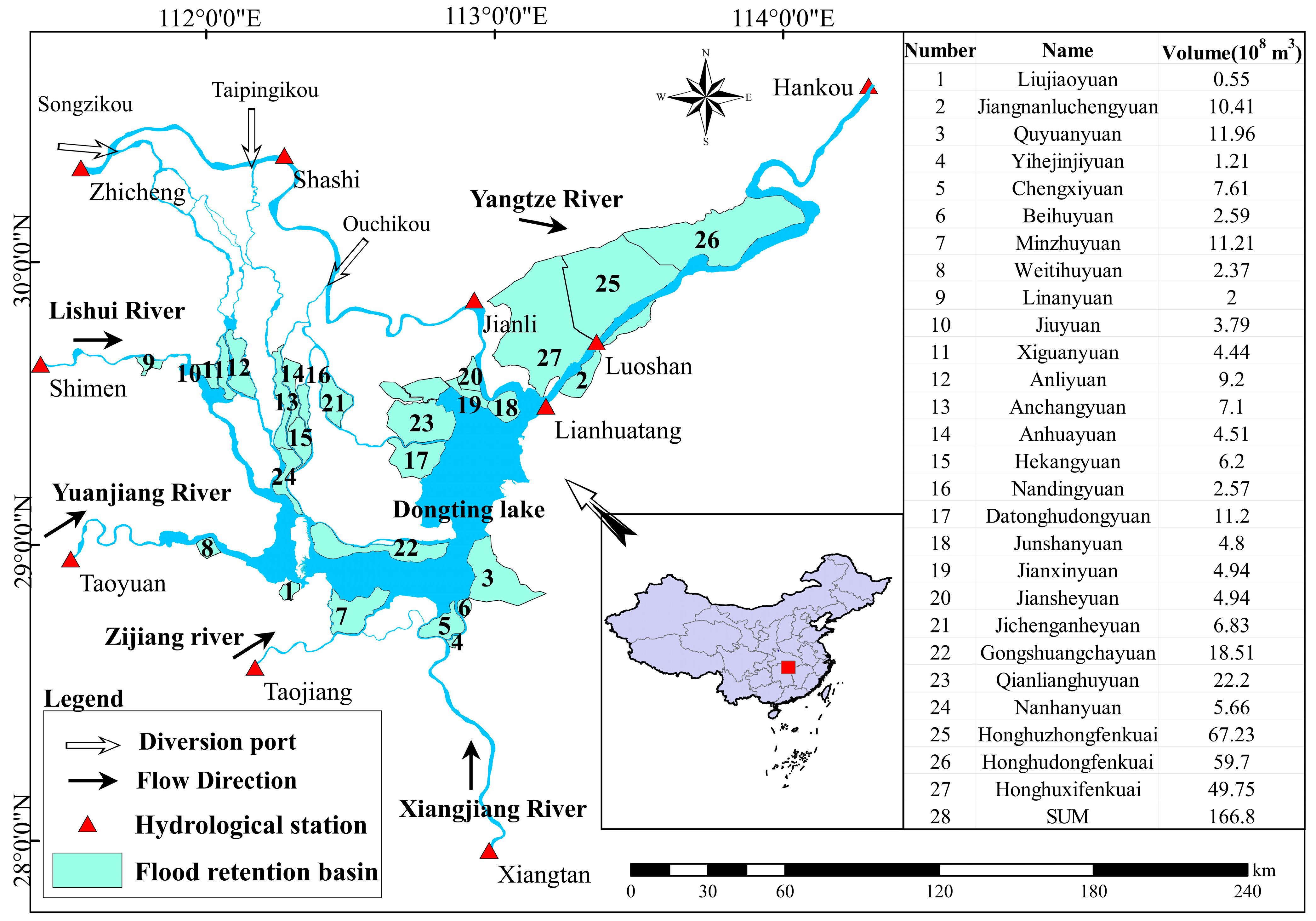

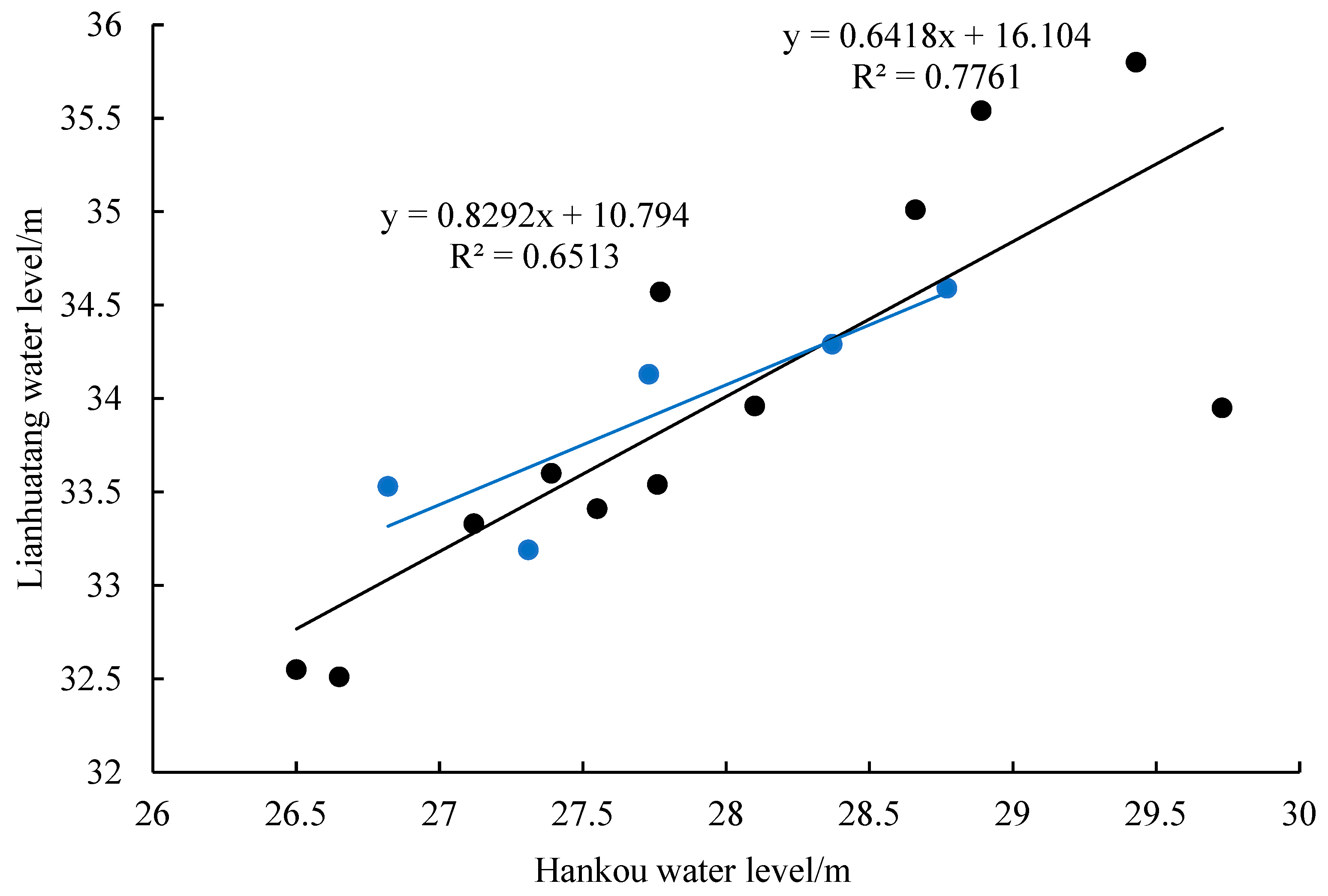
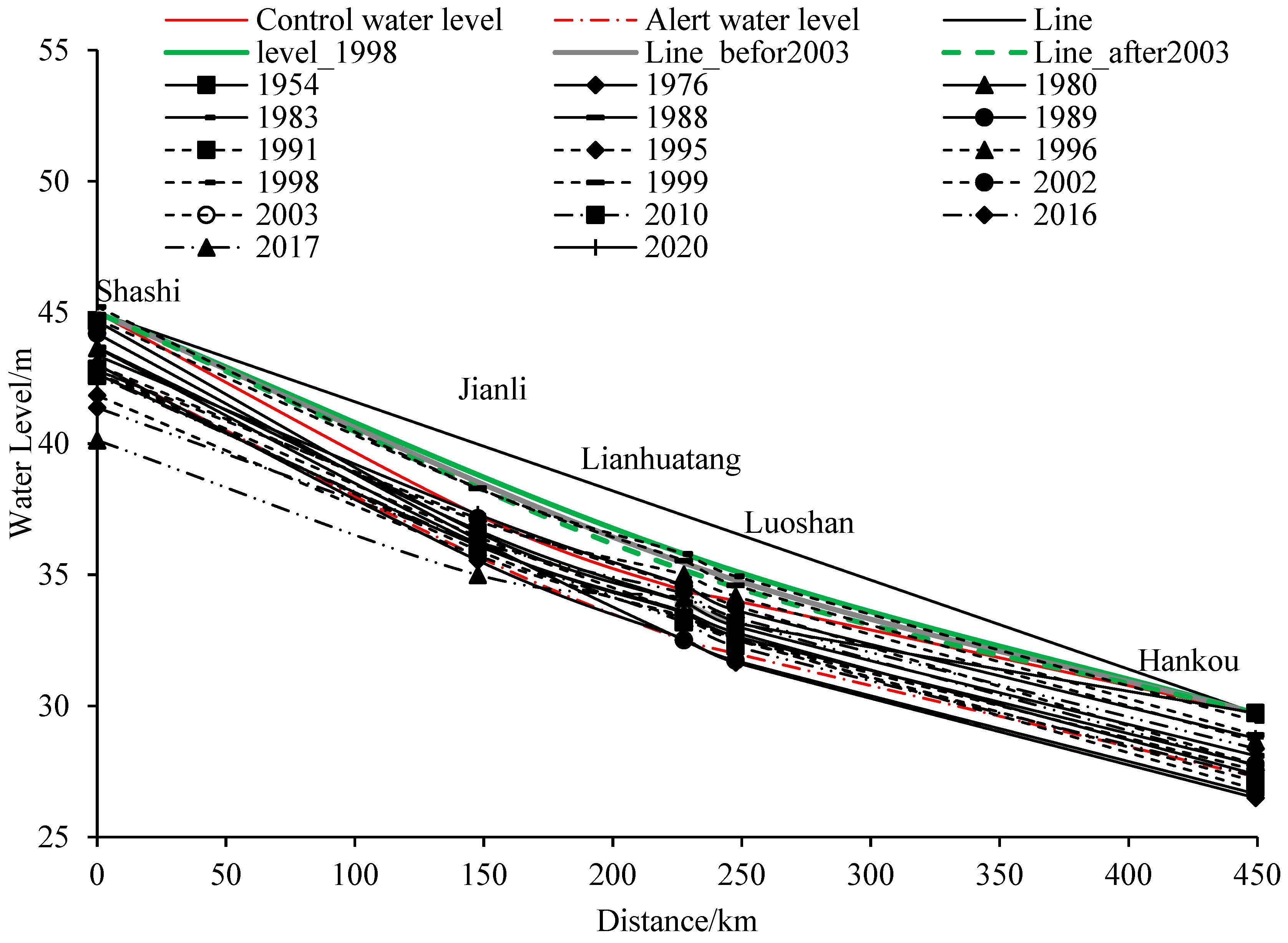
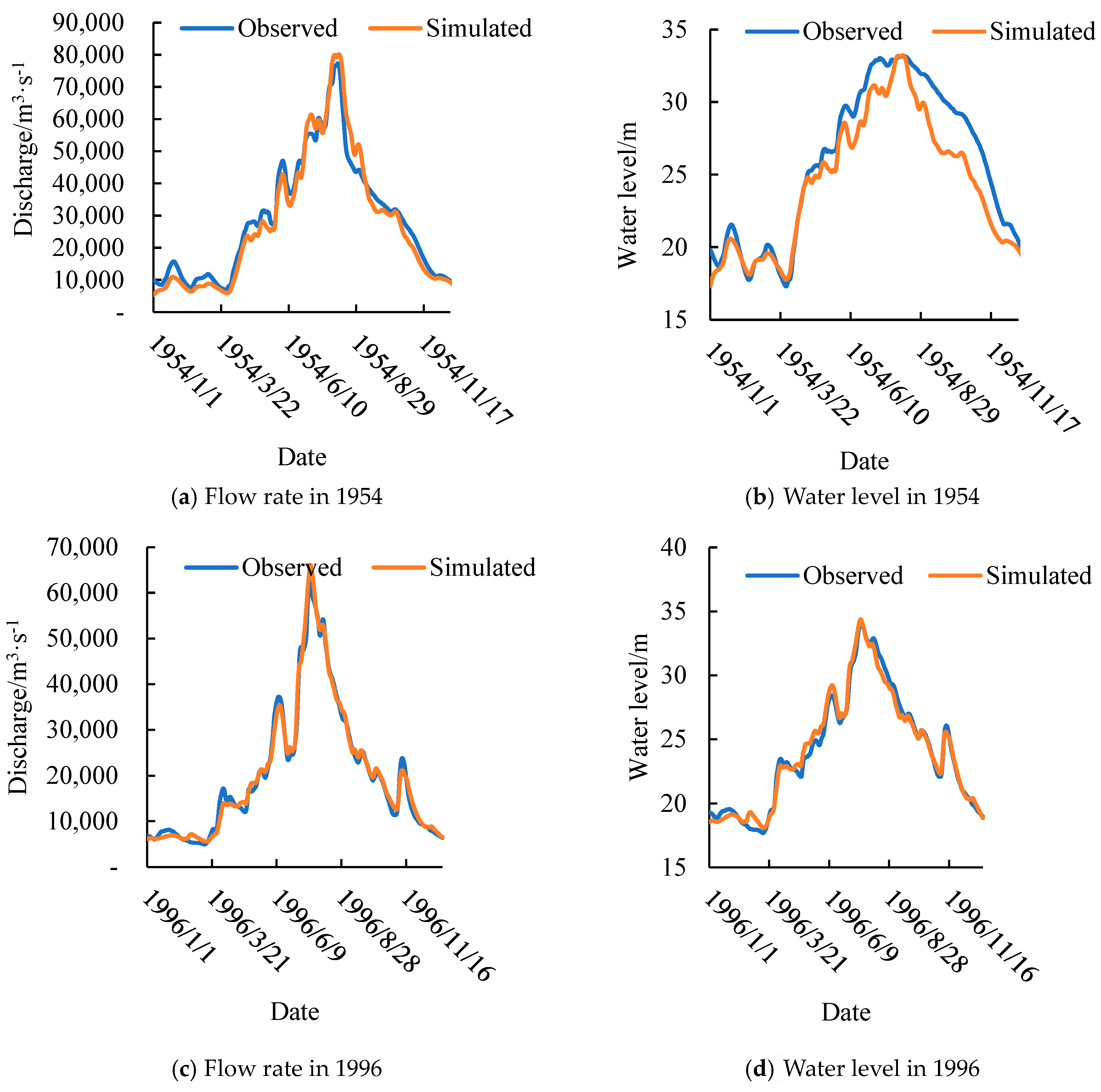
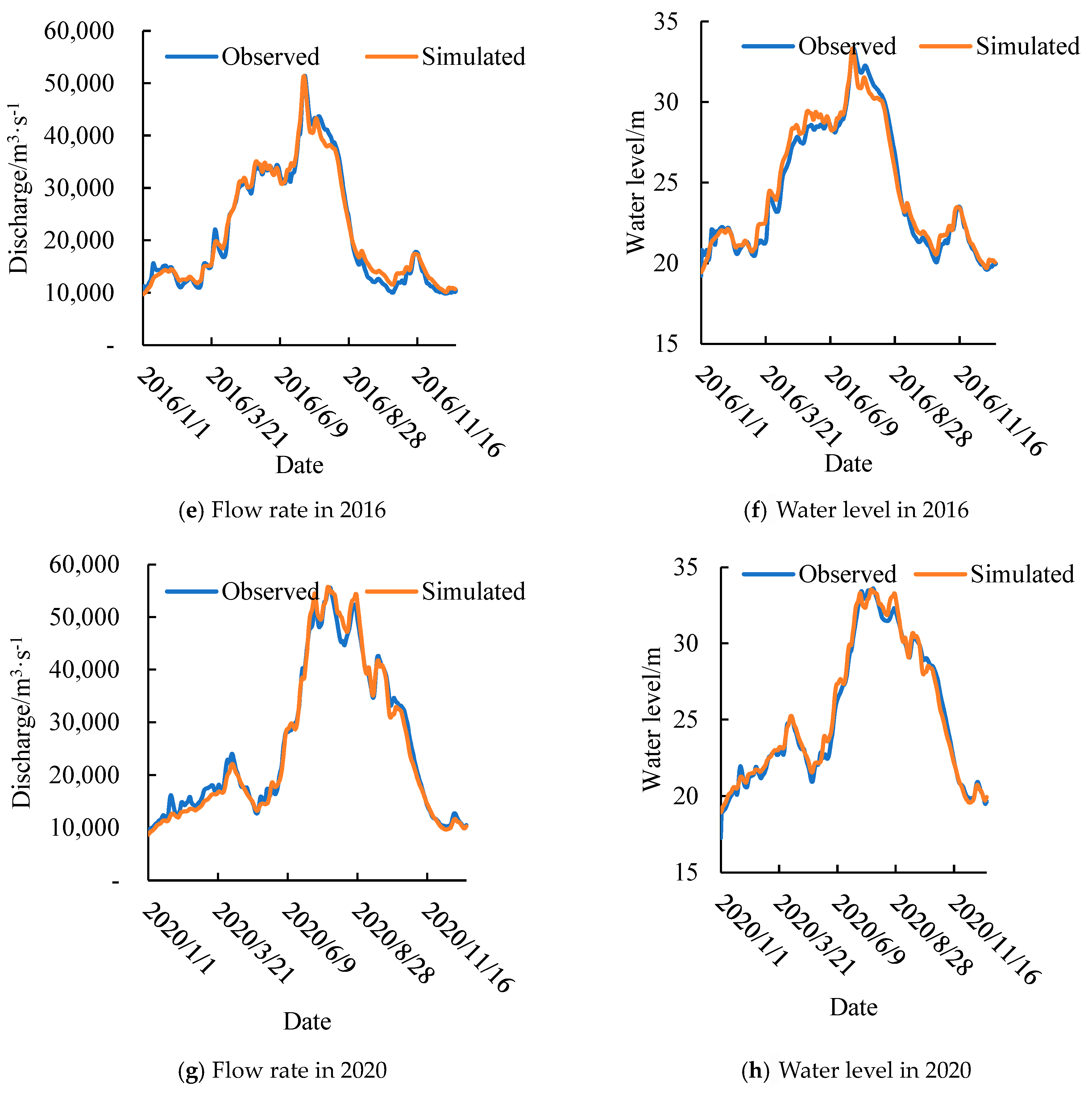
| Factors | Stations | Years |
|---|---|---|
| Discharge | Xiangtan, Taojiang, Taoyuan, Shimen, Zhicheng, Lianhuatang, Luoshan | 1954, 1983, 1995, 1996, 1998, 1999, 2002, 2003, 2016, 2017, 2020 |
| Water level | Lianhuatang, Luoshan | |
| Precipitation | Xiangtan, Taojiang, Taoyuan, Shimen, Zhicheng, Changsha, Changde, Yueyang |
| Scenarios | Year | Control Water Level (m) | Note |
|---|---|---|---|
| 1 | 1954 | 34.40 | Current controlled water level |
| 2 | 1954 | 34.90 | Current operating water level |
| 3 | 1954 | 35.18 | Projected water level after the Three Gorges Dam operation |
| 4 | 1954 | 35.45 | Projected water level before the Three Gorges Dam operation |
| 5 | 1954 | 35.80 | Highest historical water level |
| 6 | 1998 | 34.40 | Current controlled water level |
| 7 | 1998 | 34.90 | Current operating water level |
| 8 | 1998 | 35.18 | Projected water level after the Three Gorges Dam operation |
| 9 | 1998 | 35.45 | Projected water level before the Three Gorges Dam operation |
| 10 | 1998 | 35.80 | Highest historical water level |
| 11 | 1954 | 34.40 | Activate Flood Storage and Detention Areas |
| 12 | 1998 | 34.40 | Activate Flood Storage and Detention Areas |
| 13 | 1954 | 34.40 | \ |
| 14 | 1998 | 34.40 | \ |
| Year | Discharge | Water Level | |||||
|---|---|---|---|---|---|---|---|
| NSE | Absolute Error of Peak Flood Discharge (m3/s) | k2 | NSE | Absolute Error of Peak Water Level (m) | k1 | m | |
| 1954 | 0.86 | 2643.7 | 0.15 | 0.86 | 0.04 | 2.21 | 0.24 |
| 1983 | 0.95 | −797.8 | 0.19 | 0.95 | −0.08 | 2.03 | 0.25 |
| 1988 | 0.98 | 326.1 | 0.19 | 0.98 | −0.18 | 2.00 | 0.25 |
| 1989 | 0.94 | 47.7 | 0.17 | 0.94 | −0.1 | 3.24 | 0.21 |
| 1995 | 0.99 | 70 | 0.17 | 0.99 | 0.14 | 1.81 | 0.27 |
| 1996 | 0.99 | 71 | 0.13 | 0.99 | 0.26 | 1.93 | 0.26 |
| 1998 | 0.98 | 1712.5 | 0.18 | 0.99 | −0.18 | 2.04 | 0.25 |
| 1999 | 0.99 | 10.8 | 0.14 | 0.99 | 0.03 | 2.04 | 0.25 |
| 2002 | 0.97 | 144.4 | 0.17 | 0.97 | −0.20 | 2.23 | 0.24 |
| 2003 | 0.98 | −379.3 | 0.15 | 0.98 | −0.23 | 2.55 | 0.23 |
| 2016 | 0.98 | −72.4 | 0.13 | 0.98 | −0.02 | 1.00 | 0.32 |
| 2017 | 0.98 | 201.1 | 0.14 | 0.98 | −0.14 | 1.51 | 0.28 |
| 2020 | 0.99 | 128.6 | 0.16 | 0.99 | −0.08 | 1.17 | 0.31 |
| Average | - | 315.88 | - | - | −0.06 | - | - |
| Scenarios | Year | Control Water Level (m) | Peak Discharge/34.4 m (m3/s) | Peak Water Level (m) | Excess Flood Volume (108 m3) | ||
|---|---|---|---|---|---|---|---|
| Before | After | Reduction | |||||
| 1 | 1954 | 34.40 | 73,770/56,300 | 37.2 | 178.64 | - | - |
| 2 | 1954 | 34.90 | 73,770/56,300 | 37.2 | 178.64 | 79.57 | 99.07 |
| 3 | 1954 | 35.18 | 73,770/56,300 | 37.2 | 178.64 | 69.26 | 109.38 |
| 4 | 1954 | 35.45 | 73,770/56,300 | 37.2 | 178.64 | 44.18 | 134.46 |
| 5 | 1954 | 35.80 | 73,770/56,300 | 37.2 | 178.64 | 14.21 | 164.43 |
| 6 | 1998 | 34.40 | 68,280/56,300 | 36.4 | 81.40 | - | - |
| 7 | 1998 | 34.90 | 68,280/56,300 | 36.4 | 81.40 | 39.66 | 41.74 |
| 8 | 1998 | 35.18 | 68,280/56,300 | 36.4 | 81.40 | 28.26 | 53.14 |
| 9 | 1998 | 35.45 | 68,280/56,300 | 36.4 | 81.40 | 7.81 | 73.59 |
| 10 | 1998 | 35.80 | 68,280/56,300 | 36.4 | 81.40 | 5.90 | 75.5 |
| Scenarios | Year | Activated Flood Retention Basins | Peak Discharge (34.4 m) | Peak Water Level (m) | Excess Flood Volume (108 m3) | ||||||
|---|---|---|---|---|---|---|---|---|---|---|---|
| Before (m3/s) | After (m3/s) | Decay Rate | Before | After | Reduction | Before | After | Reduction | |||
| 11 | 1954 | 5, 8, 9, 17, 22, 23, 26 | 73,770 (56,300) | 59,700 (53,900) | 19.07% (4.03%) | 37.2 | 34.9 | 2.30 | 178.64 | 55.04 | 123.6 |
| 12 | 1998 | 8, 9, 22, 26 | 68,280 (56,300) | 56,000 | 17.98% (0.53%) | 36.4 | 34.4 | 2.00 | 81.40 | 0 | 81.4 |
| Serial Number | Conditions of River–Lake Interactions | Peak Water Level of Lianhuatang Station (m) | Peak Discharge of Luoshan Station (m3/s) | Excess Flood Volume (108 m3) | |
|---|---|---|---|---|---|
| 34.4 | 35.8 | ||||
| 1 | 1983 | 34.6 | 65,580 | 3.4 | - |
| 2 | 1988 | 33.3 | 60,610 | - | - |
| 3 | 1989 | 33.3 | 60,399 | - | - |
| 4 | 1995 | 34.6 | 59,502 | 3.2 | - |
| 5 | 1996 | 34.2 | 59,944 | - | - |
| 6 | 1998 | 34.6 | 60,736 | 2.3 | - |
| 7 | 1999 | 34.5 | 61,570 | 0.6 | - |
| 8 | 2002 | 33.9 | 63,840 | - | - |
| 9 | 2003 | 33.5 | 60,961 | - | - |
| 10 | 2016 | 35.7 | 59,914 | 57.2 | - |
| 11 | 2017 | 34.0 | 60,772 | - | - |
| 12 | 2020 | 37.2 | 73,770 | 178.64 | 14.21 |
Disclaimer/Publisher’s Note: The statements, opinions and data contained in all publications are solely those of the individual author(s) and contributor(s) and not of MDPI and/or the editor(s). MDPI and/or the editor(s) disclaim responsibility for any injury to people or property resulting from any ideas, methods, instructions or products referred to in the content. |
© 2024 by the authors. Licensee MDPI, Basel, Switzerland. This article is an open access article distributed under the terms and conditions of the Creative Commons Attribution (CC BY) license (https://creativecommons.org/licenses/by/4.0/).
Share and Cite
Zhao, W.; Ji, W.; Wang, J.; Jiang, J.; Song, W.; Wang, Z.; Lv, H.; Lu, H.; Liu, X. Research on Flood Storage and Disaster Mitigation Countermeasures for Floods in China’s Dongting Lake Area Based on Hydrological Model of Jingjiang–Dongting Lake. Water 2025, 17, 1. https://doi.org/10.3390/w17010001
Zhao W, Ji W, Wang J, Jiang J, Song W, Wang Z, Lv H, Lu H, Liu X. Research on Flood Storage and Disaster Mitigation Countermeasures for Floods in China’s Dongting Lake Area Based on Hydrological Model of Jingjiang–Dongting Lake. Water. 2025; 17(1):1. https://doi.org/10.3390/w17010001
Chicago/Turabian StyleZhao, Wengang, Weizhi Ji, Jiahu Wang, Jieyu Jiang, Wen Song, Zaiai Wang, Huizhu Lv, Hanyou Lu, and Xiaoqun Liu. 2025. "Research on Flood Storage and Disaster Mitigation Countermeasures for Floods in China’s Dongting Lake Area Based on Hydrological Model of Jingjiang–Dongting Lake" Water 17, no. 1: 1. https://doi.org/10.3390/w17010001
APA StyleZhao, W., Ji, W., Wang, J., Jiang, J., Song, W., Wang, Z., Lv, H., Lu, H., & Liu, X. (2025). Research on Flood Storage and Disaster Mitigation Countermeasures for Floods in China’s Dongting Lake Area Based on Hydrological Model of Jingjiang–Dongting Lake. Water, 17(1), 1. https://doi.org/10.3390/w17010001





